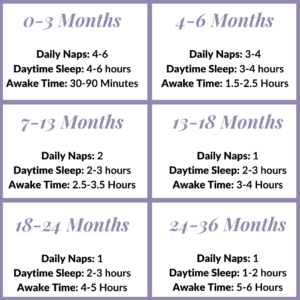Beating Short Naps
Nap time, one of the most coveted times for parents. We rely on nap time to catch up on sleep ourselves, catch up on housework, laundry, TV shows… or a time to pay bills, answer emails, online shop or do work. But when “me time” is interrupted because nap time fell short… the day seems to go a lot slower and the hours are a lot longer.
Daytime sleep is just as important as nighttime sleep. And when children get the appropriate amount of daytime sleep they need for their age, they thrive.
To truly get restorative sleep, naps should be about one hour. The average sleep cycle for a baby under 9 months is 50 minutes. Sleeping for less than this amount of time means baby only got one sleep cycle. We need baby to push past that first sleep cycle in order to get the restorative sleep they need to get through the day.
To be clear, naps ranging anywhere between 20 minutes to 2 hours are TOTALLY NORMAL for kids under five months. Babies under five months of age are not developmentally ready to consolidate naps. In fact, naps only start to consolidate when your baby is five months. It’s not to say it can’t or doesn’t happen for some babies, but it’s totally normal and common for babies to have an inconsistent nap schedule the first five months.
There are lots of reasons why your little one could be experiencing short naps, below are some of the top culprits.
Not all naps are created equal
As the day progresses, naps get harder or shorter. Most parents experience the first nap of the day to be the easiest and longest nap. By the time the third nap rolls around things can fall apart. It’s NORMAL!
Usually the last nap of the day is the shortest, especially for children between four to six months old. That can actually be a good thing! The nap before bedtime is usually just a catnap to help your child make it to bedtime without becoming overtired or interfering with bedtime. A 20-40 minute catnap is all baby needs for that 3rd nap.
Age Matters
For babies under five months, it’s okay to extend naps by offering a little consoling. Try rocking baby for 10-15 minutes to see if baby can get back to sleep. Offer a pacifier if baby will take it. Maybe a little shush pat without pick up can help settle them back to sleep. Sometimes baby needs a little more assistance getting to the next sleep cycle.
I know what you’re probably thinking, “rock baby back to sleep? Won’t I be creating a sleep association or sleep crutch?” Again, I recommend doing this for babies UNDER five months. And NO, you will not ruin your chances of having an independent sleeper.
Petite Sleep Story: I personally sleep trained my daughter around four months of age. She learned to fall asleep on her own and get herself back to sleep if she woke up. Previously, she was being rocked and re-rocked to sleep. As I recommend, establish nighttime sleep first before working on naps. So while her nighttime sleep was established, I still rocked her to sleep for naps and placed her in the crib. I followed her sleepy cues, minded her wake windows, and had a general idea of what time she went down for her naps. Which still ranged in length.
Around five months I started to notice she would squirm and wiggle and couldn’t get comfortable when I was rocking her for her naps. One day I decided to just place her in the crib and walk away like I do for bedtime. She fell asleep right away. WHAT?! I got the sense from then on that she didn’t want to be rocked to sleep. And she didn’t! She had learned to self-soothe and was happy to roll over and put herself to sleep and back to sleep for ALL sleep periods. By rocking her, I was interfering with her self settling process. In fact, I was stimulating her. Being present in the room and rocking her just kept her awake and ready to play.
This situation can be pretty common for babies with established nighttime sleep. Once nighttime sleep is established, and baby is of the age where they can developmentally consolidate naps (5 months), sometimes naps just fall into place. Remember, all babies WANT to sleep. They just need to learn the skills.
Don’t be afraid to help the little ones stretch their naps with some assistance from you. You can still have an independent sleeper. And remember, naps are tough. It will take longer to see results compared to night sleep. Continue to stay consistent in order to see improvement.
Sleep is a learned skill
The behavior of sleep is a learned skill for A LOT of babies. Similar to teaching our kids how to eat, speak, walk… we need to teach them healthy sleep habits. Some babies are naturally great sleepers. Much like some kids are more athletic or more artistic. It comes naturally to them.
But for a majority of babies, naps are a developmental process that take time. Baby needs to learn the sleep skill in order for naps to get longer. If they haven’t learned to put themselves to sleep, it’s harder for them to put themselves BACK to sleep. Longer naps WILL come, but it might take some practice on both ends to make it happen. Establishing nighttime sleep first is typically needed in order to get longer daytime naps.
Routine
I preach constantly about creating the ideal sleep environment and implementing a consistent routine. Those two elements are the cornerstone to developing a healthy sleep foundation.
You have a bedtime routine, right? (RIGHT?) But do you have a nap time routine? Did you ever consider a nap time routine? It’s important to have a routine in place before all sleep times. The nap time routine should be a shorter version of your bedtime routine.
Start to slow down whatever activity you are doing. Talk about nap time. Go up and settle into your routine. Maybe start with a diaper change, swaddle if applicable, offer a feeding… for toddlers you might read a book. Then it’s blinds down, sound machine on, in bed, and lights out.
Your nap time routine should be no longer than 10 minutes (unless offering a feeding.) It’s a simple way to wind the body down and signal that sleep is coming. Talking about nap time (for toddlers) will help alleviate any surprises. Talking about what you’re doing throughout the routine (for babies) will help your child manage expectations from an early age. “Mommy is changing baby’s diaper!” This can work for toddlers too. I like to tell my daughter, “First, diaper. Then books. Then nap.” She understands the order and repeats to me, and with me, as we proceed with the routine. It helps her understand each part of the routine as we do it, and she knows when it’s time to nap.
The room is not dark enough
Light is the biggest enemy of naps and a huge culprit in both early morning wakings and short naps. Keep the room DARK. Light signals to the body that it’s time to wake up. Darkness increases melatonin levels which promote sleep.
If you’re wondering if your child will only be able to sleep in the pitch black, don’t worry. Having a healthy sleep foundation established will be the ticket to eventually learning to sleep in dim light or at daycare. But to start, you must create a dark sleep environment.
*If you have questions about daycare sleep, check out this blog post!
Know your wake windows
It’s important to understand the average wake windows of your child for their age. Understanding wake windows and knowing your child’s sleepy cues will help them avoid becoming overtired. Reference the chart below to find your child’s average wake windows.
Petite Sleep Tip: Reevaluate wake windows monthly. Sleep and wake windows are evolving constantly the first 2 years.

Fill up their tired tank
If your child isn’t tired enough, they’ll take a short nap. While they might be tired enough to fall asleep, they are not tired enough to STAY asleep.
Think of a “tired tank” like a gas tank. The tank needs to be full in order to achieve restorative sleep. That might mean you push your child to stay awake 10 minutes longer in order to burn their energy and fill the tank. Just be mindful of wake windows and never push baby to the point overtired. Little 10 minute increments at a time to extend wake time should be all that is needed.
Stay active. Be intentional about playtime. Wear out their minds and their bodies. Especially if you’re stretching their wake window. Get outside! Fresh air is the best remedy. Have a dance party! Change up your activity to something new. Helping your child stay engaged will help fill the tank and could extend their naps.
The nap before the nap
Have you ever been out and about between naps or on your way home from somewhere just before nap time (or bedtime) and baby takes a little car snooze? Even as little as 5 minutes? Those little snoozes before a sleep period can actually be detrimental to nap time and cause short naps.
Remember the tired tank? All that effort wearing baby out and filling their tired tank could be wiped out in those 5 minutes and interfere with a solid nap when you get home.
Unless you plan to be out during nap time and have a child who takes great car naps, try to be home before baby gets tired enough to snooze in the car. Open the windows… turn up the music! Tell me you haven’t seen a mom cranking up the kid tunes and singing along? You know she is trying to keep her kid awake.
Car naps do happen, and it’s okay. Sometimes you can still get a decent nap if the car nap was less than 5 minutes. You could try to transfer baby to their crib, and if they wake, do your nap routine and get them down. Or you can choose to ride around the block, time willing, to allow baby to snooze a little longer. Assuming it is not a nap that will interfere with bedtime.
Sleep Props
Sleep props might be the reason your little one is taking short naps. If that’s the case, have a plan of action…
Pacifiers:
If your little one uses a pacifier and can’t stay asleep without one, they will be calling for you to replace it when it falls out. Practice having baby replace the paci themselves. Put the paci in their hand and guide their hand to their mouth. Practice this a lot during wake hours. Daytime practice is key. Do it again before a nap. If they can do it themselves, they won’t cry for you to replace it.
Tip: Scatter lots of pacifiers around the crib. Like 7 pacifiers. That way, when one falls out, they can find one with a short reach wherever they are in the crib.
Rocking:
If you rock baby to sleep, start timing it. Each day rock less and less time. Get baby used to sleeping without motion. Right before they doze off to sleep, stop rocking. Try to extend that “motionless time” longer every day before baby dozes so they get used to sleep without motion.
Additional Tips
If there is a nap that your infant is refusing to take pretty consistently, change the scenery. Go for a walk, take a car ride, change things up when you can. Sometimes young babies just need a change of scenery. The fresh air will do you both good.
If toddlers are refusing a nap or a nap becomes short pretty consistently for over a week, it might be time to drop the nap. I have a whole post about signs it’s time to drop a nap and the steps to do it, here.
This might seem kind of obvious, but make sure baby isn’t wet or hungry. Don’t let those needs interfere with nap time. Always make a diaper change part of your nap time routine.
Final Thoughts
Babies tend to sleep through the night before they can consolidate naps. Establishing night sleep first is the most scientifically proven and developmentally appropriate approach. The drive to sleep is strongest at night. Don’t expect naps to improve unless nighttime sleep is established. Once nighttime sleep has been established, start gently working on naps. Creating the ideal sleep environment and being consistent with a nap time routine is a great starting part!
If you need help establishing nighttime sleep or want more strategies to help improve naps, we offer customized sleep plans with individual attention to help get you there. Check out our services page to get started. We offer free 15-minute consultations!


Recent Comments